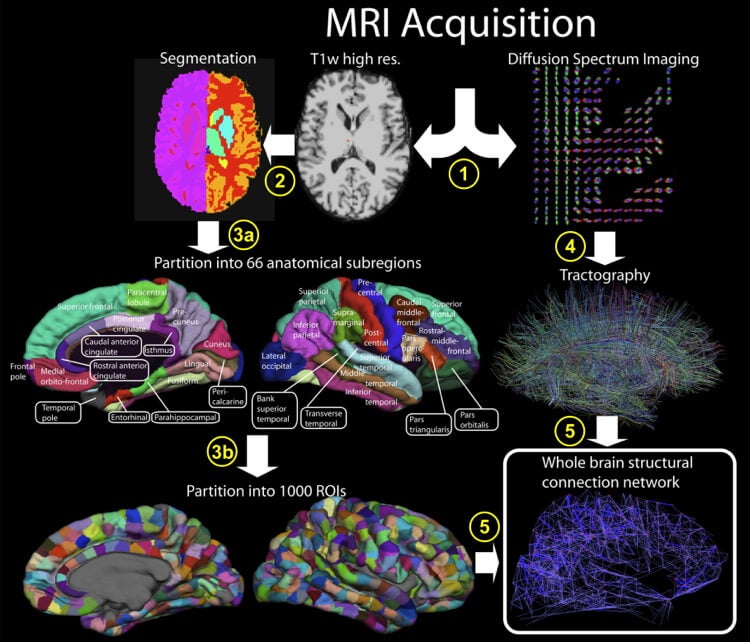With a simple scan of your brain at rest, scientists can now guess whether — on average — you are naughty or nice.
“We have now begun to see really strong evidence of a connection between measures of brain function, connectivity and many aspects of people’s lives and personality,” says lead author Dr. Stephen Smith, a biomedical engineer at the University of Oxford.
The surprisingly strong correlations, published last week in Nature Neuroscience, are the first to emerge from the ambitious Human Connectome Project (HCP), a global effort that seeks to map all the pathways between the brain’s hundreds of regions and millions of neurons, and then to relate those connectivity patterns to personality and behavior.
“I am my connectome”

So stated Dr. Sebastian Seung, a computational neuroscientist at MIT, in a 2010 TED talk that propelled the nascent field of connectomics into the public limelight. In one sentence, Seung touched on two provocative ideas.
One was philosophical: that people’s self-identity — our personality, habits, lifestyles, memories and experiences — are stored in functional connections in our brains. Disrupt the connectome (as in cases like schizophrenia), and we lose our core identity.
The other idea was more of a scientific prophecy: by advancing brain-imaging technologies, we may be able to map out the wiring of our brains in unprecedented detail. Similar to geographical maps, which allowed explorers to venture to the edge of the world, a brain atlas may push the frontier of neuroscience forward by offering an in-depth visualization of the inner workings of our minds.
“The days of just looking at one part of the brain are waning,” says Dr. Arthur Toga at the University of Southern California, a lead scientist in the HPC project.
Launched six years ago with an initial fund of $40 million, the HPC is scanning the brains of 1,200 adults with fMRI. A major branch of the project focuses on the brain at rest — that is, when it’s not concentrating on a specific task but rather allowed to wander. These “resting state connectomes” are thought to reflect how different areas of the brain are hooked up in a “locked and loaded” state, in case a sudden future task requires them to efficiently fire together.
(This video reconstructs and visualizes a brain’s connectome with diffusion MRI.)
But there’s more: each brain scan is linked to reams of demographic and personality data summarized by hundreds of different traits. These range from objective measures such IQ test scores, attention span and socioeconomic status, to self-reported factors like life satisfaction, personality, and whether they had used drugs or shown physical aggression in the past.
It’s a treasure trove ripe for data mining. Smith and his team dug deep.
Good brains, bad brains
The team wasn’t simply interested in relating one personality or success factor to another. From the onset, explained Smith, we wanted to use a single integrated analysis, and see whether specific brain connectivity patterns are associated with specific sets of correlated traits, either good or bad.
The team took the data from 461 scans and ran a massive computer program to create an average map of the brain’s resting state across 200 different regions. Then in every participant, the scientists looked at how much those regions talked to each other, effectively charting out where the strongest links lie and what the strength of the connections are.

Finally, in a computational tour-de-force, the team added 280 different traits to the pool of brain scan data, and for each participant performed canonical correlation analysis — a type of statistical wizardry that helps unearth relationships between datasets with hundreds of complex variables.
The result was stark and stunning: the brain connectivity patterns could be aligned in a single axis, where one end was associated with positive traits — such as more education, better memory and physical performance — whereas the other with negative ones, such as rule-breaking and poor sleep quality.
People on the “positive” side of the axis also had stronger connectivity between brain networks associated with higher cognitive functions, including memory, language, introspection and imagination.
It’s incredibly impressive, says Dr. Marcus Raichle, a neuroscientist at Washington University, that scans of the brain at rest were sufficient to condense vastly variable life experiences into a single, simple axis. With one scan, you can distinguish people with successful traits, leading successful lives versus those who don’t, he says.
Obviously for each person there’s going to be an error bar in guessing who they are as a person by just looking at their brain connectivity, stressed Smith, but overall the association is very strong.
Building a good connectome
The study begs the obvious question: which way does the influence go? Are our brains’ wiring patterns leading us to success or failure in life, or are life experiences shaping the connections in our brains?
For now, says Smith, we don’t know the answer, and it’s very likely that the direction of causality goes both ways. To test causality, we would need intervention studies that impose positive traits — say, enforced education — and see whether that imprints a “good” connectome on the brain.
That’s in the future, but for now we can look for traits that correlate with positive brain connections, and tweak them in a way that pulls the brain towards the “positive” end of the axis.
Marijuana use in recent weeks, for example, was one of the factors that drove a brain more towards the “bad” end of the axis. This suggests that pot is a negative life trait that should be prioritized for further study.
But scientists caution that “good” and “bad” are relative, and must be placed into social context — is it fair to consider marijuana use for medical reasons as negative?
A person’s placement on the positive-negative scale also isn’t a proxy for general intelligence. For example, people with good hand-eye coordination tended to slide towards the “bad” side of the axis.
There’s so much that we still need to sort out, says Van Wedeen, a neuroscientist at the Massachusetts General Hospital.
This is just a taste of what’s to come — with the HCP in full swing, it’s likely that a further deluge of data — how we develop as kids, how our brains age in health and disease — will provoke more questions than answers.
But it’s a good place to start.
Image Credit: Shutterstock.com; brewbooks/Flickr; Hagmann P, Cammoun L, Gigandet X, Meuli R, Honey CJ, et al/Wikimedia Commons



